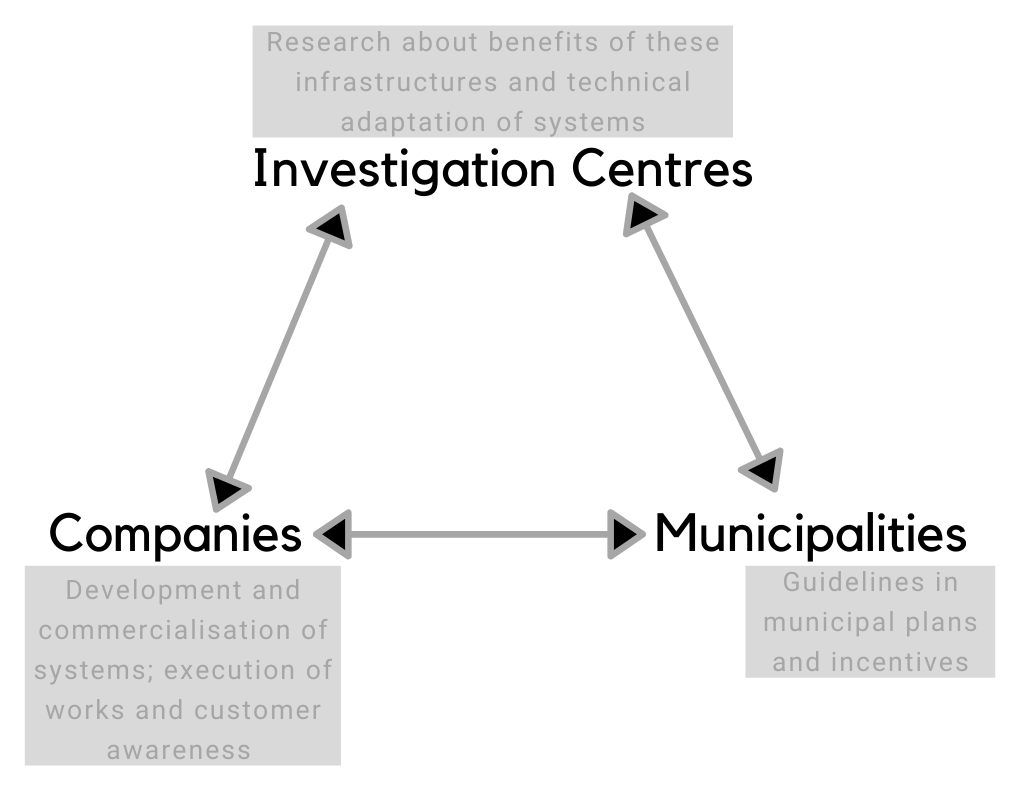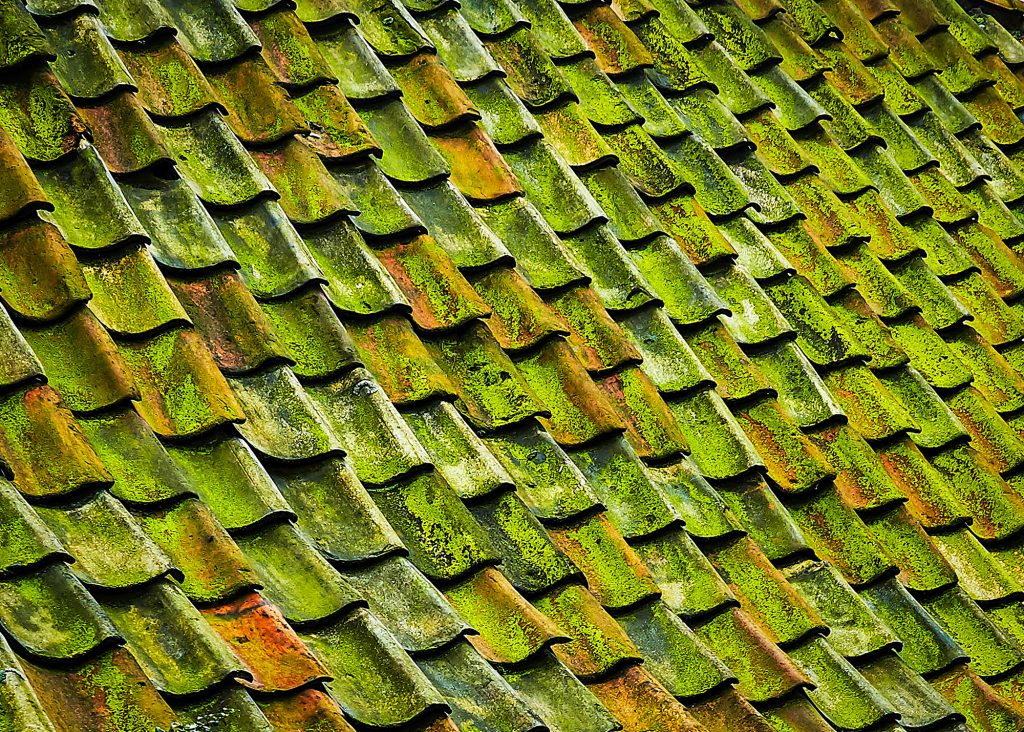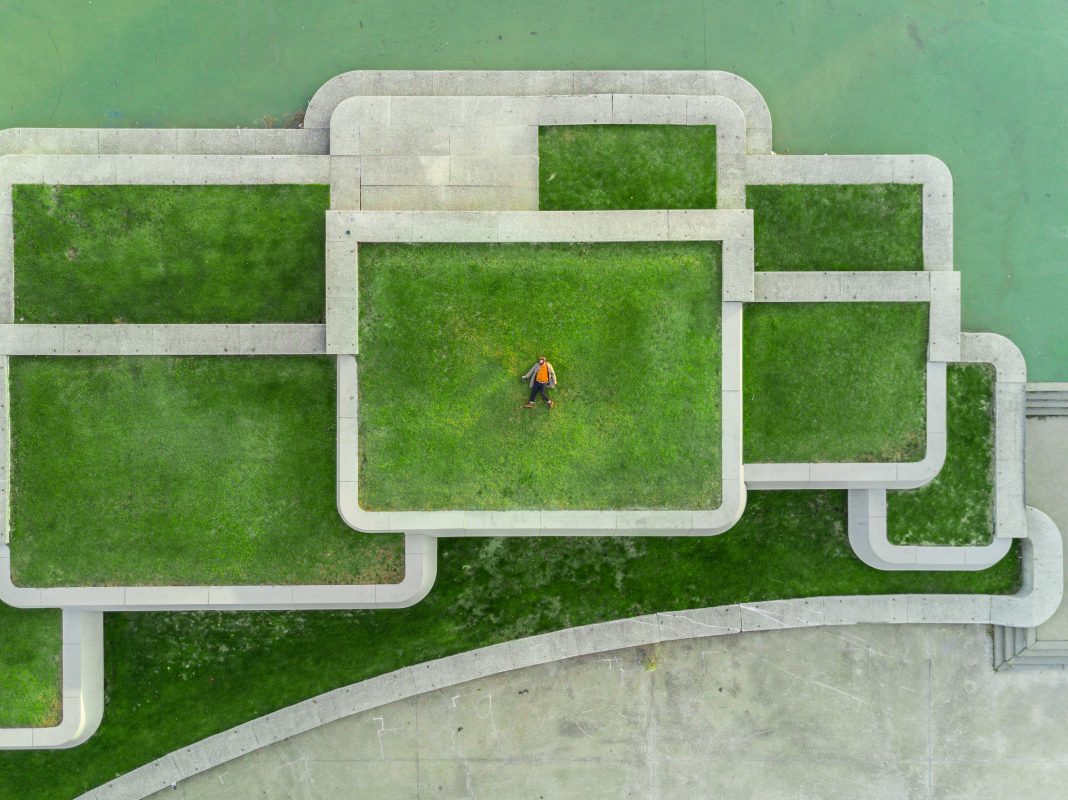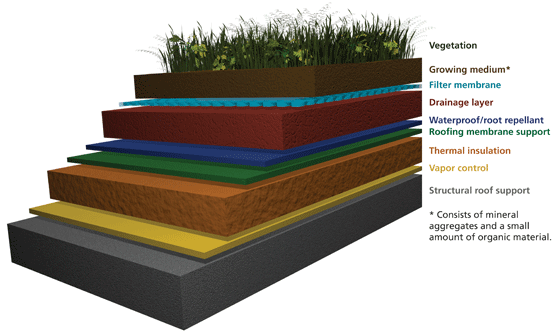Wouldn’t it be nice to go on your roof on a hot summer’s day, bringing a book and fresh lemonade with you, lying back in a deckchair and enjoying the sunny day – without actually burning to death? From providing shade and food to being a peaceful space, green roofs truly are modern versions of green havens among the clusters of concrete and noise in cities. But how exactly do you go about getting your very own green roof? And is it worth it? Find out here!
We spoke with Jéssica Fogeiro, Landscape Architect and Executive Coordinator at ANCV Green Roofs – a non-profit organisation whose goal is to spread and provide information about green infrastructure, specifically green roofs. The organisation was established in 2015 and is run by volunteers, who mainly work with municipalities, investigation centres and various companies. As Jéssica explains, their work could be simplified into a triangle:

It’s usual for companies to resort to ANCV for a partnership with research centres to develop new products or systems. Often, new needs or challenges arise (e.g. adapting to some surface or climate, needing a different type of product), which require research to understand what works better and how to create the product in a more sustainable way. Municipalities need scientific evidence to often convince superiors to invest in a certain project, or to create a certain incentive – the research here again provides assistance. There are also other instances, where the investigation centres require a company to create a case study (e.g. a space for implementing green roof to test different things), or for an investigation project with a certain system.
The aim of ANCV is to disseminate these studies, and support their discussion with municipalities in facts, to demonstrate their benefit. By bringing research results to companies, it is easier for company leaders to understand if the building they are constructing is sufficient and sustainable. ANCV acts as a bridge between municipalities and people that want to implement the systems. “The mission of ANCV is to get everyone to cooperate with each other, as this is the only way to make progress,“ says Jéssica.
Why Green Roofing?
There are numerous benefits to owning a green roof:
- Air purifying,
- Noise reduction,
- Water management,
- Thermal fluctuations,
- Aiding biodiversity,
- Fresh produce,
- Well-being & happiness,
- Increase in real estate value.
Read more about it in detail in our The Case for Green Roofs.
Affordability
All perfectly nice and fine, but let’s talk about another essential factor – is it affordable? Just how expensive are green roofs?
There’s no concrete answer to this question, as climate conditions, the country’s policies and other variables need to be taken into account. However, in the USA, the average installation cost for an extensive roof is approx. $10 to $20 per square foot, and for an intensive roof, the cost ranges from $25 to $35 per square foot – an average homeowner can therefore expect to pay between $15,000 and $30,000 for a 1,500 sq. ft. roof. While in the UK, the prices for an extensive green roof range from £50 to £100, and for an intensive between £60 and £150 – an average homeowner can therefore expect to pay between £75,000 and £150,000 for the same 1.500 sq. ft. roof.
No doubt it’s easier with incentives. This, of course, varies from country to country, so it’s best to check with your local green roof organisation if certain funds are available. ANCV provides a list of green roof policies around the world on their website, which could also serve as a starting point for finding incentives.
Overall, green roofs seem like a great investment. Not only do they increase the value of the real estate (as mentioned before), but they basically pay for themselves in 25 years. Typically, the membrane of a conventional roof needs major repairs every 20-25 years, while a green roof membrane can last up to twice as long. And as Jéssica insightfully adds, if you take into account the whole project of designing and building a house, the green roof is just a minimum part of that (money-wise) – it’s a gain.

Steps to Your Very Own Green Roof
So, you’ve decided green roofing is something you want to do, understand the gains and pains – great! Now, the next step is to actually install one. How?
- Get acquainted with your local policies. ANCV provides a helpful, easy-to-use guide here.
- This step is very important: hire a specialist. Green roofs are not to be taken lightly, there’s more to it than just putting a bunch of plants on your roof. Hiring a specialist will relieve you of stress, hard work and any possible future damages.
- Building the green roof on either a new building or on an already existent one:
a) On a new building
Planning to put a green roof on a new, not yet built building is definitely easier to plan. “The key aspect is to define from the beginning that you want a green roof. That’s the easiest and most cost-effective way,” advises Jessica. The process usually goes like this:
- Talk to the architect and explain in detail what you want (e.g. a lighter green roof with less weight or a bigger one with trees).
- The architect designs a skeleton of the house, and the landscape architect designs the rest. In some countries you can also hire a green roof specialist – a simple Google search is all you need to check if they are available in your region.
- Green roof specialists (or landscape architects) then take various variables into account (e.g. climate, percentage of rain, temperature change, specifications of the place) to create guidelines on which type of plants to use.
- Voilà, the roof is ready to be greened.
b) On an existing building
This process is trickier, but certainly not impossible:
- Find out and define the maximum possible weight the building can support.
- If the building can support the capacity for sustaining a green roof, all that needs to be done is adding the needed layers:
- If the roof can’t support the needed weight, it needs to first be reinforced. When it’s supported and can sustain the green roof, construction can begin.
- Now you can follow the same process of consulting with either a landscape architect or a green roof specialist as when designing a green roof on a new building.
What about if the property isn’t yours, you’re just a renter with a ‘green’ passion? Unfortunately, there isn’t much you can do. You can suggest the idea to your landlord, state the case, explain the bill saving costs in the long run, even recommend doing some work on your own – however, the final decision falls to the owner of the place. There are other simpler ways to greening up your apartment, like requesting better insulation or requesting an access to the roof and setting up a few potted plants or modular vegetation trays there, which they will likely be more willing to agree to. Still, if green roofing is something you’re super keen on, give it a go, ask, the worst that can happen is you get a “no”.
Maintenance
Again, maintenance of green roofs differs from country to country, depending on the climate it’s in. However, this chart (designed for the USA, but can be applied elsewhere) represents an overall idea of taking care of your sustainable roof:
Green roofs are basically like gardens – plants need to be watered, trimmed and replanted (in some climates more, in some less), and it’s recommended to book a specialist’s visit about twice a year. They will check if the drain is clogged and make sure that everything is okay and running smoothly. Easy-peasy, green roof maintenance is truly not difficult nor expensive. On average, annual maintenance costs span from approx. $0.80 to $1.60 per square meter – certainly not a bad investment, considering the cut in energy, water and (potentially) food bills the green roof will cause.
Green Roofs in a Nutshell
It does seem like investing in a sustainable roof is the way to go – cutting out the costs of bills for you, while doing something good for the environment. Whatever the reason for greening your roof may be, take advice from a specialist and architect beforehand, and go from there. Together you will surely find a way for everyone involved to be happy and satisfied with the finished product. The city, the animals, your wallet, and your physical and mental health will thank you.





[…] and extensive, is a much-established and recognized worldwide practice,” says Elizaveta. Learn how to do it on your building here. However, not all buildings can support a green roof. If this is the case, Elizaveta […]